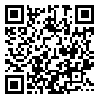Volume 12, Issue 1 (1-2008)
IBJ 2008, 12(1): 43-48 |
Back to browse issues page
Abstract:
Background: When fetal red cells enter the maternal circulation from placenta, an event would be happened that is described as feto-maternal hemorrhage (FMH). This life-threatening condition could be detected by using RBC antigens (surface antigens and intracellular antigens). Therefore, the measurement of fetal RBC in an artificial model would be useful to calculate FMH and consequently the dosage of Rhogam for prophylaxis. The aim of the present study was to evaluate FMH in an artificial mixture model. Methods: A series of 40 artificial specimens were prepared consisting of Rh(D) negative adult blood (non-immunized) spiked with varying amounts of Rh(D) positive cord blood from mothers between 20-30 years old in Shahid Beheshti Hospital, Tehran, Iran. Monoclonal anti-D and anti-HbF (fetal hemoglobin) were used for detection of fetal RBC in artificial mixture sample modeling. Results: This study showed that the percentage of fetal cells in artificial sample for anti-D antigen is in ranges of 0.28%-0.32% for a 0.25% dilution mixture, and 1.3%-2.05% for the mixture with dilution 2%. In addition, the ranges of data for anti-HbF staining was obtained 0.2%-0.34% for the 0.25% dilution sample, and the ranges of 1.04-1.8% for the 2% dilution. The regression analysis indicated that the correlation of anti-D assessment with expected standard method was r2 = 0.9672 and anti-HbF assessment was r2 = 0.8842. Conclusion: Although both molecule targets could be used for detection of fetal RBC, in this model, anti-D staining was more accurate than anti-HbF staining. However, since anti-D can not be utilized for low-density or weak phenotype and other incompatibility, the anti-HbF labeling could be used for all FMH.
Type of Study: Full Length/Original Article |
Subject:
Related Fields
| Rights and permissions | |
 |
This work is licensed under a Creative Commons Attribution-NonCommercial 4.0 International License. |





